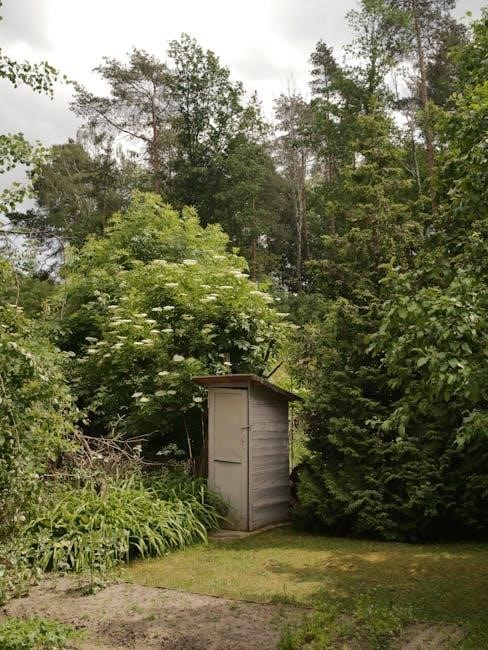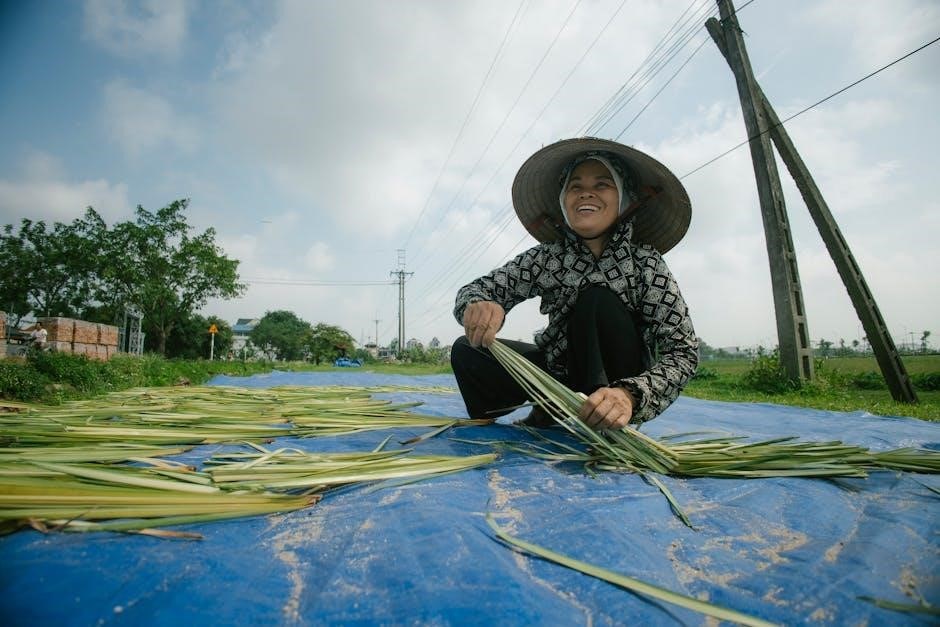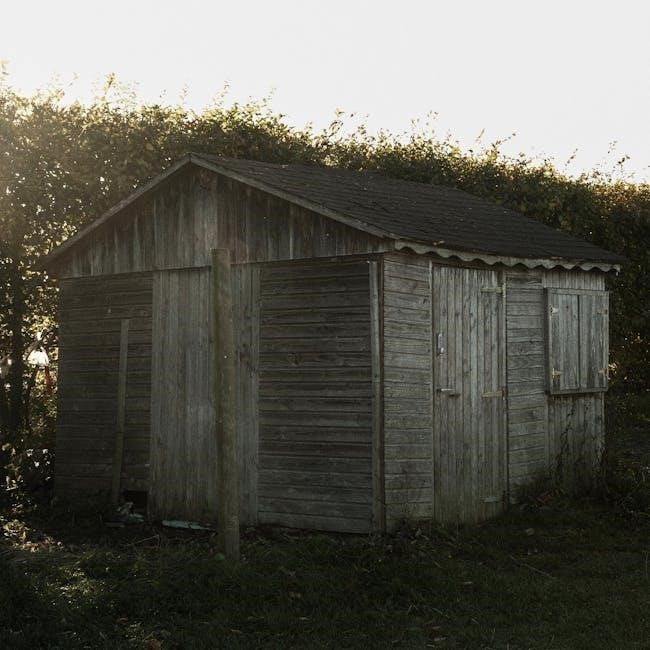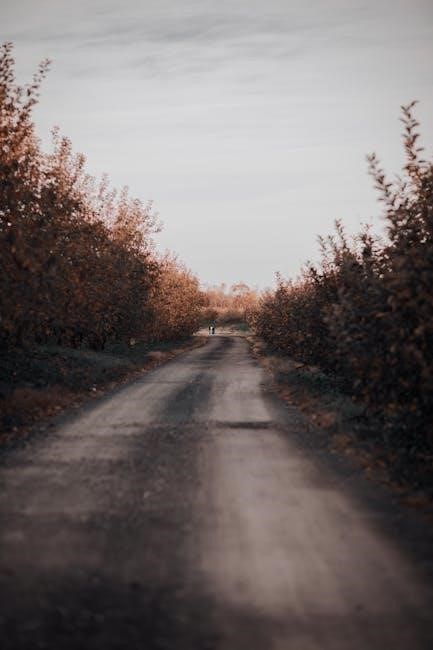manual of woody landscape plants
Woody landscape plants are essential for their beauty‚ functionality‚ and environmental benefits․ They provide structure‚ shade‚ and habitat‚ enhancing outdoor spaces․ Manual of Woody Landscape Plants is a key resource for understanding their identification‚ care‚ and uses in landscape design․
1․1 Importance of Woody Plants in Landscaping
Woody plants are foundational in landscaping‚ offering aesthetic‚ functional‚ and environmental benefits․ They provide structure‚ shade‚ and habitat‚ while enhancing beauty through flowers‚ foliage‚ and bark․ Their durability and versatility make them ideal for various settings‚ from urban to natural landscapes․ Manual of Woody Landscape Plants emphasizes their role in sustainable design‚ supporting biodiversity and climate regulation‚ making them indispensable in creating resilient outdoor spaces․
1․2 Brief History of Woody Plant Use in Landscapes
Woody plants have been integral to landscapes for centuries‚ valued for their durability and aesthetic appeal․ Ancient civilizations used trees and shrubs for shade‚ structure‚ and ornamentation․ Their popularity evolved through design trends‚ from formal gardens to naturalistic landscapes․ Manual of Woody Landscape Plants highlights their historical significance‚ showcasing how they’ve shaped outdoor spaces across cultures and eras‚ enduring as essential elements in landscape design․
Author Background: Michael A․ Dirr
Michael A․ Dirr is a renowned horticulture professor at the University of Georgia‚ celebrated for his extensive research and contributions to the field of woody plants․
2․1 Biography of Michael A․ Dirr
Michael A․ Dirr is a distinguished horticulturist and professor at the University of Georgia․ Known as a leading expert on woody plants‚ Dirr has authored numerous influential books‚ including Dirr’s Hardy Trees and Shrubs․ His work emphasizes plant identification‚ ornamental traits‚ and practical applications in landscaping․ Dirr’s research and teaching have significantly shaped modern horticulture and landscape design practices․
2․2 Contributions to Horticulture and Landscape Design
Michael A․ Dirr has made significant contributions to horticulture through his extensive research‚ teaching‚ and authorship․ His book‚ Manual of Woody Landscape Plants‚ is a seminal work‚ providing detailed insights into plant identification‚ ornamental traits‚ and cultural practices․ Dirr’s efforts have advanced landscape design‚ offering practical solutions for plant selection and care․ His work has influenced both professionals and enthusiasts‚ earning him recognition as a leader in horticulture education and practice․

Evolution of the Manual of Woody Landscape Plants
The Manual of Woody Landscape Plants has evolved through multiple editions‚ with the sixth edition being a major revision․ It incorporates new insights from Dr․ Dirr’s research at Hillier Arboretum․
3․1 Editions and Updates Over the Years
The Manual of Woody Landscape Plants has undergone significant updates across its editions․ The sixth edition‚ released in 2009‚ is a comprehensive guide‚ offering detailed insights into plant identification‚ ornamental traits‚ and cultural practices․ It includes Dr․ Dirr’s observations from his sabbatical at Hillier Arboretum‚ enhancing its depth․ This edition is widely praised for its thorough revision‚ making it an indispensable resource for horticulture professionals and enthusiasts alike․
3․2 Key Features of the Latest Edition
The latest edition of the Manual of Woody Landscape Plants is a comprehensive resource‚ featuring detailed descriptions of trees‚ shrubs‚ and vines․ It includes updated information on plant identification‚ ornamental characteristics‚ and cultural practices․ The sixth edition incorporates Dr․ Dirr’s insights from his sabbatical at Hillier Arboretum‚ enhancing its depth․ It also offers practical advice for landscape designers and gardeners‚ making it an essential tool for horticulture professionals and enthusiasts alike․
Plant Identification and Classification
Woody plants are classified botanically and identified through characteristics like flowers‚ leaves‚ and bark․ The manual provides detailed descriptions and visual aids for accurate identification and classification․
4․1 Botanical Classification of Woody Plants
Woody plants are classified into families‚ genera‚ and species based on shared characteristics․ The Manual of Woody Landscape Plants organizes them systematically‚ aiding horticulturists in understanding relationships and traits․ This classification helps in identifying plants accurately and selecting suitable species for specific landscapes․ The manual also includes updated taxonomic changes‚ ensuring users have the most current information for effective plant management and design․
4․2 Visual Identification Techniques
Visual identification of woody plants involves examining leaves‚ bark‚ flowers‚ and fruits․ The Manual of Woody Landscape Plants provides detailed descriptions and images to aid in distinguishing species․ Key characteristics such as leaf shape‚ venation‚ and flower color are emphasized․ This method ensures accurate identification‚ even for similar species‚ and is supported by the manual’s comprehensive taxonomy and illustrative resources․

Ornamental Characteristics of Woody Plants
Woody plants offer diverse ornamental features like vibrant flowers‚ colorful foliage‚ and unique bark textures․ The Manual of Woody Landscape Plants highlights these traits to enhance landscape beauty and design․
5․1 Flowers‚ Foliage‚ and Bark
Woody plants captivate with their vibrant flowers‚ varied foliage textures‚ and striking bark patterns․ Flowers add color and attract pollinators‚ while foliage provides year-round interest through shape and hue․ Unique bark textures‚ like peeling or ridged patterns‚ enhance winter landscapes․ These ornamental traits‚ detailed in the Manual of Woody Landscape Plants‚ offer endless design possibilities for creating visually dynamic and functional outdoor spaces․
5․2 Seasonal Appeal and Color Variations
Woody plants offer dynamic seasonal interest‚ with flowers blooming in spring‚ foliage transforming in autumn‚ and bark standing out in winter․ Color variations‚ such as vibrant fall hues or spring blossoms‚ create layered beauty․ The Manual of Woody Landscape Plants highlights these traits‚ helping designers select plants that provide year-round appeal and adapt to changing seasons‚ ensuring landscapes remain engaging throughout the year․

Cultural Requirements for Woody Plants
Understanding cultural requirements of woody plants is crucial for their health and longevity․ Factors include soil type‚ watering needs‚ sunlight exposure‚ and nutrient intake․ The Manual of Woody Landscape Plants provides updated care guidelines‚ ensuring optimal growth and sustainability in various environments․
6․1 Soil Preferences and pH Tolerance
Soil preferences and pH tolerance are critical for the health of woody plants․ The Manual of Woody Landscape Plants highlights how different species thrive in specific soil types‚ from acidic to alkaline conditions․ For example‚ oak trees prefer slightly acidic soils‚ while maples and lilacs tolerate a broader pH range․ Understanding these preferences ensures proper planting and maintenance‚ promoting robust growth and longevity․ Dirr’s insights help landscapers make informed decisions․
6․2 Watering‚ Sunlight‚ and Nutrient Needs
Proper watering‚ sunlight exposure‚ and nutrient supply are vital for healthy growth․ Woody plants vary in water requirements‚ with some preferring moist soils and others drought tolerance․ Sunlight needs range from full sun to partial shade‚ depending on species․ Nutrient-rich soils‚ especially nitrogen‚ phosphorus‚ and potassium‚ promote robust growth․ Dirr’s manual provides detailed guidance on balancing these factors to optimize plant health and performance in diverse landscape settings․
Propagation Methods
Propagation methods for woody plants include seed germination and cutting techniques․ Michael Dirr’s manual details both traditional and modern practices to ensure successful plant multiplication and healthy growth․
7․1 Seed Propagation Techniques
Seed propagation is a fundamental method for growing woody plants․ Michael Dirr’s manual highlights techniques like cold stratification to break dormancy and proper soil preparation for optimal germination․ Specific species‚ such as oak and yellowwood‚ may require varied conditions․ Germination times differ‚ with some seeds sprouting quickly and others taking months․ Patience and precise monitoring are crucial for successful seed propagation‚ ensuring healthy seedlings develop into robust plants․
7․2 Cutting and Grafting Methods
Stem cuttings and grafting are popular for propagating woody plants‚ ensuring genetic consistency․ Manual of Woody Landscape Plants details techniques like rooting hormones and optimal timing․ Grafting combines desirable traits‚ such as disease resistance‚ onto robust rootstocks․ These methods are especially effective for species like yellowwood and oak‚ offering precise control over plant characteristics and improving success rates in challenging environments․
Landscape Uses of Woody Plants
Woody plants enhance landscapes through shade‚ screening‚ and erosion control․ They add beauty with flowers‚ foliage‚ and seasonal changes‚ serving both functional and aesthetic purposes in design․
8․1 Trees‚ Shrubs‚ and Vines in Different Settings
Trees‚ shrubs‚ and vines are versatile in landscapes‚ providing shade‚ screening‚ and beauty․ In urban settings‚ flowering trees like Cladrastis lutea excel‚ while shrubs offer structure․ Vines‚ such as Clematis‚ enhance walls․ Residential landscapes benefit from evergreen shrubs for year-round interest; Naturalized areas use native species to mimic ecosystems․ Each plant type serves unique purposes‚ from erosion control to seasonal appeal‚ as detailed in Manual of Woody Landscape Plants․
8․2 Ground Covers and Their Applications
Ground covers are low-growing‚ spreading plants ideal for covering large areas․ They reduce erosion‚ suppress weeds‚ and add aesthetic value․ Species like Pachysandra and Vinca minor thrive in shady conditions‚ while Sedum and Phlox excel in sun․ Ground covers are perfect for slopes‚ borders‚ or areas with poor soil․ They provide year-round interest and require minimal maintenance‚ making them versatile for residential and commercial landscapes‚ as noted in Manual of Woody Landscape Plants․

Plant Selection Criteria
Plant selection criteria focus on climate hardiness zones and disease resistance‚ ensuring plants thrive in specific environments with minimal maintenance․
9․1 Climate Hardiness Zones
Climate hardiness zones are crucial for selecting plants adapted to specific temperature ranges․ The Manual of Woody Landscape Plants provides detailed zone maps‚ helping landscapers choose species suited to their region․ This ensures plants thrive‚ reducing failure risks․ Dirr’s manual highlights zone tolerance for each plant‚ making it a vital tool for regional landscaping success and sustainability․ Hardiness zone data is essential for optimal plant performance and longevity․
9․2 Disease and Pest Resistance
Selecting woody plants with inherent disease and pest resistance is vital for sustainable landscapes․ The Manual of Woody Landscape Plants highlights species with natural immunity‚ reducing reliance on chemicals․ Dirr’s expertise helps identify resilient plants‚ such as disease-resistant cultivars‚ and provides strategies to promote healthy growth․ This approach minimizes maintenance and environmental impact‚ ensuring thriving‚ pest-free landscapes․ Resistance is key to long-term plant health and ecosystem balance․

Challenges in Woody Landscape Plant Management
Managing woody plants involves overcoming pests‚ diseases‚ and environmental stresses․ The Manual of Woody Landscape Plants addresses these challenges‚ offering solutions for healthy plant growth and sustainability․
10․1 Common Pests and Diseases
Woody plants often face challenges from pests like aphids‚ scale insects‚ and borers‚ as well as diseases such as powdery mildew and root rot․ These issues can weaken plants and reduce their aesthetic value; Proper identification and timely treatment are crucial for maintaining health․ The Manual of Woody Landscape Plants provides guidance on recognizing and managing these common threats‚ ensuring long-term sustainability in landscapes․
10․2 Environmental Stress Factors
Environmental stress factors such as extreme temperatures‚ drought‚ and poor soil conditions significantly impact woody plants․ These stresses can lead to weakened immune systems‚ reduced growth‚ and increased susceptibility to pests and diseases․ The Manual of Woody Landscape Plants highlights these challenges‚ emphasizing the importance of selecting resilient species and implementing adaptive care practices to mitigate environmental pressures and ensure plant health․

Case Studies and Examples
The Manual of Woody Landscape Plants features case studies of successful landscapes‚ offering insights into effective plant selection and design․ These examples highlight practical lessons learned from real-world applications․
11․1 Successful Landscapes Featuring Woody Plants
Dr․ Dirr’s manual highlights landscapes showcasing woody plants’ versatility․ The Hillier Arboretum in England‚ with its diverse hardy species‚ exemplifies effective design․ These examples demonstrate how trees‚ shrubs‚ and vines create stunning‚ functional outdoor spaces‚ blending aesthetic appeal with ecological benefits‚ as detailed in the manual’s case studies․
11․2 Lessons Learned from Real-World Applications
Dr․ Dirr’s manual shares insights from real-world applications‚ emphasizing plant selection based on climate zones and soil conditions․ His observations from the Hillier Arboretum highlight the importance of disease resistance and adaptive species․ These lessons stress the need for sustainable practices‚ ensuring woody plants thrive in diverse landscapes while minimizing environmental stress and pest issues․

Future of Woody Landscape Plants
The future of woody plants lies in sustainable breeding‚ focusing on disease resistance and climate adaptability․ Emerging trends emphasize eco-friendly practices and diverse species development for resilient landscapes․
12․1 Emerging Trends in Plant Breeding
Emerging trends in plant breeding focus on developing disease-resistant‚ climate-resilient‚ and low-maintenance woody plants․ Breeders are prioritizing sustainable practices‚ leveraging biotechnology‚ and exploring hybridization to create versatile species․ The Manual of Woody Landscape Plants highlights advancements in molecular breeding and genetic diversity to meet environmental challenges‚ ensuring woody plants remain integral to future landscapes․
12․2 Sustainability and Environmental Impact
Sustainability is crucial for woody plants in modern landscapes‚ emphasizing eco-friendly practices․ The Manual of Woody Landscape Plants underscores the role of native species in reducing environmental impact․ By promoting water conservation‚ minimizing chemical use‚ and enhancing biodiversity‚ sustainable landscaping with woody plants supports healthier ecosystems and mitigates climate change‚ ensuring their continued relevance in environmentally conscious designs․
The Manual of Woody Landscape Plants is a definitive guide‚ offering insights into identification‚ care‚ and uses of woody plants․ Its comprehensive approach ensures lasting relevance in horticulture and landscape design‚ empowering professionals and enthusiasts alike․
13․1 Summary of Key Takeaways
Michael Dirr’s Manual of Woody Landscape Plants offers a comprehensive guide to identifying‚ selecting‚ and caring for woody plants․ It emphasizes their ornamental characteristics‚ cultural requirements‚ and propagation methods․ The book is a go-to resource for professionals and enthusiasts‚ offering practical advice for enhancing landscapes with trees‚ shrubs‚ and vines․ Updated editions include visual guides and expert insights‚ ensuring it remains a vital tool in horticulture․
13․2 Final Thoughts on the Importance of Woody Plants
Woody plants are indispensable in landscaping‚ offering aesthetic beauty‚ ecological balance‚ and functional benefits․ Their resilience and versatility make them essential for sustainable design․ Manual of Woody Landscape Plants underscores their value‚ providing insights for selecting and caring for these plants․ By integrating woody plants‚ landscapes become vibrant‚ resilient‚ and environmentally harmonious‚ benefiting both natural ecosystems and human-made spaces for generations to come․

References and Further Reading
Key resources include Manual of Woody Landscape Plants by Michael A․ Dirr‚ offering comprehensive insights․ Online tools and botanical databases provide additional detailed information for further study․
14․1 Recommended Books and Resources
The Manual of Woody Landscape Plants by Michael A․ Dirr is a definitive guide‚ offering detailed insights into plant identification‚ ornamental traits‚ and cultural practices․ Other notable resources include Dirr’s Hardy Trees and Shrubs and online botanical databases․ These texts provide comprehensive information for horticulture professionals and enthusiasts‚ ensuring well-informed decisions in landscape design and plant care․
14․2 Online Tools for Plant Identification and Care
Online platforms like PlantSnap and Leafsnap offer advanced plant identification features using AI and visual databases․ The USDA Plant Hardiness Zone Map is a crucial tool for determining suitable planting regions․ Additionally‚ university extension services and botanical garden websites provide detailed care guides‚ complementing resources like Michael Dirr’s manual․ These digital tools enhance accessibility for gardeners and professionals alike‚ ensuring accurate and up-to-date information․
Glossary of Terms
A comprehensive glossary defining key horticultural terms‚ such as hardiness zone‚ evergreen‚ deciduous‚ and grafting‚ essential for understanding plant care and identification in the Manual of Woody Landscape Plants․
15․1 Definitions of Key Horticultural Terms
This section explains essential horticultural terms like evergreen (plants retaining leaves year-round) and deciduous (shedding leaves seasonally)․ It also covers hardiness zones‚ indicating plant survival regions‚ grafting‚ a propagation method‚ and propagation itself‚ including techniques like cuttings and seed planting․ These definitions aid in understanding plant care and selection‚ as detailed in the Manual of Woody Landscape Plants․

Appendices
The appendices include plant hardiness zone maps and propagation and care calendars‚ providing practical tools for growers and landscapers to plan and maintain woody plants effectively․
16․1 Plant Hardiness Zone Maps
Plant hardiness zone maps are essential tools for determining where specific woody plants can thrive․ These maps outline temperature ranges and climate conditions‚ guiding plant selection․ Updated with current data‚ they help landscapers and gardeners choose suitable species for their regions․ The Manual of Woody Landscape Plants includes detailed zone maps‚ ensuring accurate and successful plant placement in various environments․
16․2 Propagation and Care Calendars
Propagation and care calendars in the Manual of Woody Landscape Plants provide detailed timelines for planting‚ pruning‚ and maintaining woody plants․ These schedules ensure optimal growth and health․ By following these guidelines‚ gardeners can synchronize tasks with seasonal changes‚ maximizing plant performance․ The calendars also include specific techniques for seed propagation‚ cutting‚ and grafting‚ tailored to different regions and climate conditions․
Acknowledgments
The author extends gratitude to contributors‚ including Bonnie Dirr‚ Margaret Stephan‚ and Asta Sadauskas‚ for their invaluable support․ Special thanks to Hillier Arboretum and the University of Georgia for their assistance․
17․1 Contributions and Credits
Michael A․ Dirr acknowledges Bonnie Dirr‚ Margaret Stephan‚ and Asta Sadauskas for their exceptional contributions․ Hillier Arboretum and the University of Georgia provided critical support․ Their expertise and dedication were crucial in shaping the manual‚ ensuring its accuracy and comprehensiveness․ The collective effort has made the manual an indispensable resource for horticulture professionals and enthusiasts alike․


